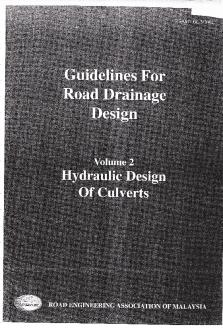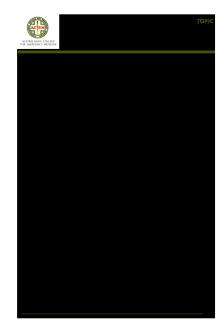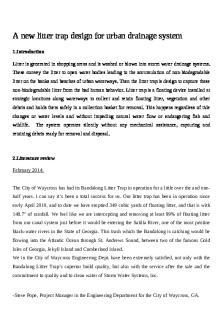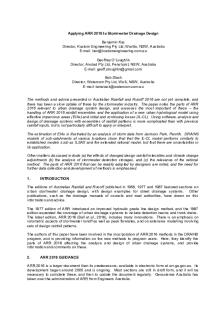REAM GUIDELINES FOR ROAD DRAINAGE DESIGN - VOLUME PDF

| Title | REAM GUIDELINES FOR ROAD DRAINAGE DESIGN - VOLUME |
|---|---|
| Author | Mie Ee |
| Pages | 64 |
| File Size | 36.1 MB |
| File Type | |
| Total Downloads | 157 |
| Total Views | 852 |
Summary
FOREWORD Road Engineering Association of Malaysia (REAM), through the cooperation and support of various road authorities and engineering institutiorri in Muluysia, publishes a series of official documents on STANDARDS, SppctptcATIoNS, GUIDELINES, MANUAL and TECHNICAL NOTES which are related to roa...
Description
FOREWORD Road Engineering Association of Malaysia (REAM), through the cooperation and support of various road authorities and engineering institutiorri in Muluysia, publishes a series of official documents on STANDARDS, SppctptcATIoNS, GUIDELINES, MANUAL and TECHNICAL NOTES which are related to road engineering. The aim of such publication is to achieve quality and consistency in road and highway construction, operation and maintenance. The cooperating bodies are:Public Works Department Malaysia (pWD) Malaysian Highway Authority (MHA) Department of Irrigation & Drainage (DID) The Institution of Engineers Malaysia (IEM) The Institution of Highways & Transportation (IHT Malaysian Branch) The production of such documents is carried through several stages. At the Forum on Technology and Road Management organized Uy fWOfnEAM in Novemb er 1997, Technical committee 6 Drainage was formed with the intention to review Arahan
Teknik (Jalan) 15/97 - INTERMEDIATE GUIDE To DRAINAGE DESIGN oF ROADS' Members of the committee were drawn from various government departments and agencies, and from the private sector including privltized road operators, engineering consultants and drainage products manufacturers and
contactors. I
;
Technical Committee 6 was divided into three sub-committees to review Arahan Teknik (Jalan) 15/97 and subsequently produced ,GUIDELINES FoR ROAD DRAINAGE DESIGN' consisting of the foll,owing vorumes: Volume 1 Volume 2 Volume 3 Volume 4 Volume 5 -
Hydrological Analysis Hydraulic Design of Culverts Hydraulic Considerations in Bridge Design Surface Drainase Subsoil Drainale
The drafts of all documents were presented at workshops during the Fourth and Fifth Malaysian Road Conferences held in 2000 and 2002 reipectively. The comments and suggestions received from the workshop participantr *"r. reviewed and incorporated in the finalized documents.
ROAD ENGINEERING ASSOCIATION OF MALAYSIA 46-A, Jalan Bola Tampar l3/r4, Section 13, 40100 Shah Alam, Selangor, Malaysia Tel: 603-5513 6521 Fax:5513 6523 e_mail: ream@po=jaring.m),
TABLE OF CONTENTS Page
2.1
INTRODUCTION
....."..2-I
2.2
GENERAL
CRITER.IA.... 2.2.I Drainage Survey 2.2.2 Site Visit
......2.1 ....2-1 ........2-2 .....2-2
....;..
... Characteristics .. 2.2.2.4Highwaterlnformation.... 2.2.2.5 Existing Structures 2.2.2.6Soiilnvestigation 2.2.3 Culvertlocation 2.2.3.1A1ignment 2.2.3.2 Vertical Profile 2.2.3.3 Structural Consideration... 2.2.2.1Topographical Features 2.2.2.2 Catchment Area 2.2.2.3 Channel Characteristics
2.3
CULVERT TYPE SELECTION
2.3.I
2.3.2
.. .
..
..2-2
.".....2-2 ......2-2 ......-.2-3 ......2-3 ....2-3 ........2-3 ....2-5 ......2-5
.,.......2-8
Type Selection Site Conditions 23.2.f Low Allowab1e 2 .3 .2.2 Depth of Cover for Traffic 2.3.2.3 Settlement of
Headwater.. Loading Culverts 2.3.2.4CulvertJoints
FACTORS TO BE CONSIDERED IN HYDRAULIC DESIGN OF CULVERT . 2.4.1 Hydrological Analysis
Culverts Procedures . 2.4.3 Freeboard 2.4.4 Length of Culvert 2.4.5 Skew of Culvert 2.4.6 GradientofCulverts 2.4.1 Scour and Seepage Countermeasures 2.4.8 Flow Velocities .
2.4.2
. . .. .
Size of 2.4.2.1Design 2.4.2.2 Minimum Size
."...2-8
.....2-8 ........2-8 ..2-9 "..2-lO
.....
......2-I0 ......2-IO ...2-10
......2-I1 .........2-I1
.....2-lI .... ".2-12 "...2-12 ......2-12 ...,......2-13 ..2-13 ..."2-I4
LIST OF FIGURES Figure 2.1 Frgure2.2 Figure 2.3 Ftgure 2"4
StreamRealignment....
Alignment of Culvert in Embankment Across Ravine. Culvert Profile Scour and Seepage Protection
Measures
."..2-4 ....2-6
.........2-7
.....2-I5
''''
iE-
'
' '-- -i-.'-
E E F
*B e
-Ei
r F e
-E
F -F
LIST OF TABLES
F
F F -F
T^yl"?l Table 2'2
Recommended Minimum Size of Cutvert Maximum Recommended Flow Velocities (m/s) for Various Conduit Materials
p
2-t1 2-16
t I
-:i ii^ *j -p'r
I
! :.
I.
-
F
I
--' F
E ,F
_T r
-T i il
li
i
! t
-i i
..-1,
LIST OF REFERENCES
.
APPENDIX 1 Reprint of Chapter 27 : Curverts, urban stormwater Management Manual for Malaysia
2-17
E) F q
*
VOLUME 2.0 - HYDR.AULIC DESIGN OF CULVER.TS
2.I
INTRODUCTION The primary purpose of culverts is to convey water under a roadway. They may also be used to restrict flow so that a controlled amount of water is discharged
while the upstream basin of the stream channel is used for detention storage. In road embankments, which traverse across val1eys, culverts are used to convey water from a hisher levei to a lower level. In1et, outiets and joints must be carefully designed so as noi to obstruct smooth
flow of the water. Attention must be paid in detailing of joints to ensure no leakage occurs because it can endanger the embankment integrity by way of washout of the soil mass.
The design of culverts involves hydraulic and structural design. This volume wi.ll
only discuss the hydraulic design of culverts. The method used is generally adopted from the publication "Chapter 27 - CULVERT, Urban Stormwater Management Manual for Malaysia" published by Jabatan Pengairan dan Saliran (JPS), copy of which is reproduced here as Appendix 1.
2.2
GENERAL CRITERIA
2.2.1
Drainage Survey
The design of a culvert begins with the drainage survey. Before the drainage survey is carried out, the designer should check with JPS or the local authorities whether past survey plans are available.
If
a drainage survey needs to be carried out,
it is
suggested that the designer
first
of all estimate the design discharge. If the estimated design discharge exceeds 30 cumec for a 50 years recurrence interval, the survey should cover a minimum of 200 metres upstream and downstream from the centre line of the proposed or existing culvert to obtain:
a) b) c) d)
sufficient channel cross sections, the streambed profile and existing water levels, the horizontal alignment of the existing sffeam channel,
invert levels and crown ievels of any existing culvert, and 11
e)
highest flood levels.
The site survey should be carried out to the extent sufficient for the proper location and design of the culvert.
2.2.2
Site Visit
A
site visit by the designer is a must to determine on site information, such
as
topographic features, catchment area, channel characteristic, highwater information and existing structures should be noted, as it can be useful in the hydraulic design.
2.2.2.1 Topographical
Features
-t
-i
Features such as residential and commercial buildings, croplands, roadways, the lay of the ground and utilities can influence the location of the culvert as it
-l
determines the direction and velocity of the location should be obtained.
I
flow.
Therefore their elevation and
I
I I
i
2.2.2.2
Catchment Area Characteristics
The designer should take note of features such as lakes, land usage, type and density of vegetation and any man-made changes or development such as dams, because these factors could alter run-off.
I
i
I
Future landuse plans of the catchment should be obtained, if available, to study the effects of future landuse changes on run-off and where necessary these effects should be taken into consideration in the culvert desisn.
2.2.2.3
Channel Characteristics
Physical characteristics of the existing stream channel such as, type of soil or rock in the streambed, the bank condition and amount of drift, and debris should also be noted as these factors could affect the durability of the culvert material used and the sizing of the culvert.
2.2.2.4 Highwater Information Highwater information which may be obtained from observation of the high water mark, local residents or Jps can be used to check results of flood estimating
)_)
procedures, establish highway grade 1ines, to locate hydraulic controls, and to check backwater effects arisine from the construction of the new culvert.
2.2.2.5 Existine Structures Considerable importance should be placed on the hydraulic performance of existing structures, some distance upstream or downstream from the proposed culvert site, which can be helpful in the design. Useful data of existins structures includes:
i) ii) iii) iv) v)
date of construction,
performance during past floods, scour indicated near the structures,
highwater elevation with datum and dates of occurrence, and structurai conditions of the structure.
2.2.2.6 Soil Investisation Sub-soil investigation should be carried out to the extent required for the design
of the culvert and soil characteristics should be obtained for design of settlement and protection against soil erosion.
2.2.3
Culvert Location
Culvert location refers to the horizontai alignment and vertical profile with respect to both roadway and stream. A proper location is important because, it affects hydraulics, the adequacy of the opening, maintenance of the culvert and possible washout of the roadway.
2.2.3.I
Alignment
The first consideration of culvert location is to place it in the natural channel to give the stream a direct entrance and a direct exit. Where this is not possible, a direct inlet and outlet can be obtained by means of channel diversion, a skewed culvert alignment or both. Realignment of the natural channel should be designed
properly so as to avoid erosion on the concave side of the channel and siltation on the inner side of the bend. Where following the original channei would result in a very long and skewed road crossing, a cheaper and practical option is to construct a stream realignment, see Figure 2.1 for
'
2-3
illustration.
z
Ld
:<
z
o
L!
u F
m trJ
(n
Z-
9I ?'
z
F
U)
O
FI
=
Lri
LiJ
O
z
L!
=I r'\ ' LrJ I al
U>
z_o i-
t,
-l
Lrl
z_l
-(Y n--
\t
Lrl
-oz
>l
z.l
't
()l
rl
I
Z
J
fit
LLJ
zz
r r
LL.J
O
u
z
o-
F
>l ,121
6q
//
I
_l
\\
I
,,
,
>l
-ll rl <
i I
I
u
tt
2-6
z
a
:gu\ss.im\i
(o)
nruttCtPATlNG SEDIMENTATION
(b)
CHANGE FROM CHANNEL GRADE MAY CAUSE SEDIMENTATION OR EROSION
PAVING OR OTHER OPEN SPILLWAY
(c)
CULVERT PLACED BILOW PROPIR GRADE WATERWAY
rYELL-,coMPrcTEo
\
FILLING-
IS
REDUCTD
- /GASION UATTRESS
(e)
HTLLSIDE GRADES.
(f) (f) CANTTLTVER
EROSION PR
NOTE:
I. 2.
PROPER CUL\€RT GRADE IS ESSENThL FOR THE PROPER FUNTIONING OF THE SIRUCTURE
3,
DIFFERENThL S€TTLEMENT SHOULD
H LF FrtL (d), (f) rHE CUL\GRT SHOULD BE LAlo ON UNIFORM BEDoINC XATERIAL FOR THE WHOLE LENGTH, TO UINIMIZE DIFFERENTIAL SETTLEMENT
rN FiALF CUl
/
8E
CONSIOERED IN THE DESIGN OF THE CULVERT STRUCTURE
FIGURE
2.3
:
CULVTRT PROFILt
2-l
EXTINSTON
tl
CULVERT TYPE SELECTION
2.3.1
Type Selection Types of culverts commonly used in this country are as follows: a)
precast reinforced concrete pipes (refer M.S. gg1: part 1, part
3:1991), b) c) d)
precast reinforced concrete box culverts (refer
2 and.part
M.s. 1293 : part 1 reinforced concrete cast-in-situ box (refer M.s. 11g5:1gg5), and culvert of other material approved by relevant authorities.
:
r99z),
culvert type selection includes the choice of materiai, shape, cross section and the number of culvert barrels that will best fit the waterway of the channel or stream. The following factors shourd be considered in any cuivefi type serection:
a) b) c) d) e) 0
design discharge, site conditions,
design life,
construction period, construction joints, and blockage due to floating debris from upstream.
If
the design discharge exceeds 60 cumecs based on a 50 years recurrence interval, consideration should be given to using a bridge structure taking into
-l
account the site constraints and economic factors.
2.3.2
Site Conditions
2.3.2.1 Low Allowable Headwater
-l I
Headwater is the water depth at the inlet of the culvert. Multiple cells culverts have to be used at places where the headwater should be kept low to get the water through quickly without ponding or flooding of the land upstream. In flat flood plain where there is no well-defined local flow path multiple culverts spread over the width of the flood plain may be more effective than a single large culvert.
2-8
The designer should also take note of the amount of debris in the channel. In be provided areas where solid waste is a problem, trash screen with bypass should a distance upstream of the culvert entrance to prevent clogging of the culvert barrel.
a)
Reinforced Concrete PiPe When two or more pipes are used, the pipes should be separated by a clear distance of about 0.3m to 0.9m to allow space for thorough compaction of
backfilling, which is essential to the side support to prevent collapse of the pipes due to unequal surcharge loading. Backfilling between pipe barrels shouid be with well-graded sancl. Proper headwalis and wing walls should be provided to prevent washouts of the sand back fill. Concrete backfill and haunching may be used in high fill areas where strength is required, and where the founding soii is soft and weak'
b)
Precast Reinforced Concrete Box
Multiple cells precast reinforced concrete box culvert should be laid without a gap between the culverts walls to provide less overall obstruction to the flow of water. Precast box culverts are normally manufactured with butt ends. To prevenr wash-in of fine particles from surrounding soil the butt joints should be wrapped all round with suitable drainage geotextile. The usage of multiple cells culverts should be considered with due care:
o
if clogging by debris is very evident then multiple cells culverts should
be
avoided, and
o
where siltation of cells at the sides of the main cell is very likely then adoption of multiple ceils culverts should also be avoided.
2.3.2.2 Depth of Cover for Traffic Loading The minimum cover over the crown of culverts to the road pavement formation level is normally dictated by traffic load and structural capacity of the culvert. 2-9
i T
-1,
a)
Reinforced Concrete pipe
The minimum cover is 0.4m. If the cover is ress than 0.4m, the pipes should be concrete encased. pipes of higher strength can arso be used but it would cost more. Reinforced concrete pipe below road pavement sharl have adequate structural strength to carry traffic load. b)
Precast Reinforced Concrete Box
Precast reinforced concrete box culverts are designed to withstand direct traffic loading. The minimum cover however is 0.1m. R.einforced Concrete Cast-in-Situ Box
It can be designed structurally to withstand direct traffic loadins.
2.3.2.3 Settlement of Culverts when culverts are liable to settle due to a high fi1l, or poor ground condition pipes should be selected which can withstand the anticipated unequal settlement. Reinforced concrete pipe can withstand anticipated unequal settlement provided rubber ring spigot and socketjoints are used.
2.3.2.4 Culvert Joints In cast-in-situ box culverts movement joints should be provided at appropriate
longitudinal intervals. The movement joints should be watertisht and detaiied to prevent wash in of backfill material.
For precast box culverts all joints should be wrapped round with non-woven geotextile to prevent wash-in of backfill material. 2.4
FACTORS TO BE CONSIDERED IN HYDRAULIC DESIGN OF CULVERT
2.4.1
Hydrological Analysis Please refer to Volume 1 Hydrological Analysis -
I
j
i
I
2-rc
2.4.2
Size of Culverts
2.4.2.1
Design Procedures
The hydraulic calculations of culverts shall be in accordance to the design procedures and worked examples as described in Chapter 27 CULYERT of "IJrban Stormwater Management Manual for Malaysia".
2.4.2.2 Minimum
Size
For the purpose of maintenance, the minimum size of a culvert is related to the length of the culvert even if the flow to be conveyed is much lesser than the discharge capacity of the culvert. The recommended rninimum sizes of culverts are as shown in Table 2.1.
Where there is a high possibility of accumulation of debris in the culvert, some reserve in cross sectional area is necessary i.e. the pipe size should be larger than
the required hydraulically adequate size.
If
an embankment with a culvert is
located on soft ground, some reserve area may aiso be necessary to compensate for a possible loss in cross sectional area due to long term settlement. Table 2.1: Recommended Minimum Size of Culvert
Length of Culvert (m)
Minimum Diameter or lleight of Culvert (m)
19
1.5
At private access road
crossing
of roadside drainage, to reduce
depth of
downstream roadside dr...
Similar Free PDFs
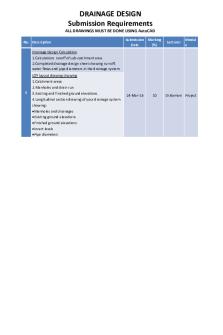
Drainage Design
- 43 Pages

GUIDELINES FOR SLOPE DESIGN
- 37 Pages
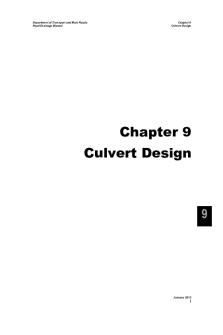
Manual Road Drainage Chapter 9
- 51 Pages

URBAN DRAINAGE DESIGN MANUAL
- 478 Pages
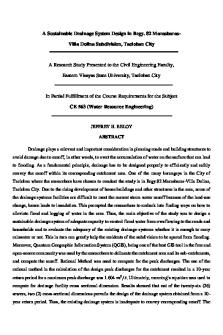
DRAINAGE SYSTEMS DESIGN
- 22 Pages

Laboratory-design-guidelines
- 12 Pages
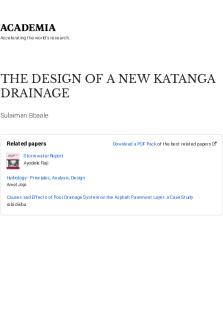
THE DESIGN OF A NEW KATANGA DRAINAGE
- 106 Pages

Drainage
- 7 Pages
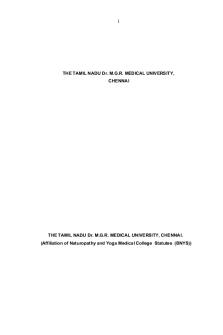
Guidelines for BNYS
- 59 Pages
Popular Institutions
- Tinajero National High School - Annex
- Politeknik Caltex Riau
- Yokohama City University
- SGT University
- University of Al-Qadisiyah
- Divine Word College of Vigan
- Techniek College Rotterdam
- Universidade de Santiago
- Universiti Teknologi MARA Cawangan Johor Kampus Pasir Gudang
- Poltekkes Kemenkes Yogyakarta
- Baguio City National High School
- Colegio san marcos
- preparatoria uno
- Centro de Bachillerato Tecnológico Industrial y de Servicios No. 107
- Dalian Maritime University
- Quang Trung Secondary School
- Colegio Tecnológico en Informática
- Corporación Regional de Educación Superior
- Grupo CEDVA
- Dar Al Uloom University
- Centro de Estudios Preuniversitarios de la Universidad Nacional de Ingeniería
- 上智大学
- Aakash International School, Nuna Majara
- San Felipe Neri Catholic School
- Kang Chiao International School - New Taipei City
- Misamis Occidental National High School
- Institución Educativa Escuela Normal Juan Ladrilleros
- Kolehiyo ng Pantukan
- Batanes State College
- Instituto Continental
- Sekolah Menengah Kejuruan Kesehatan Kaltara (Tarakan)
- Colegio de La Inmaculada Concepcion - Cebu
